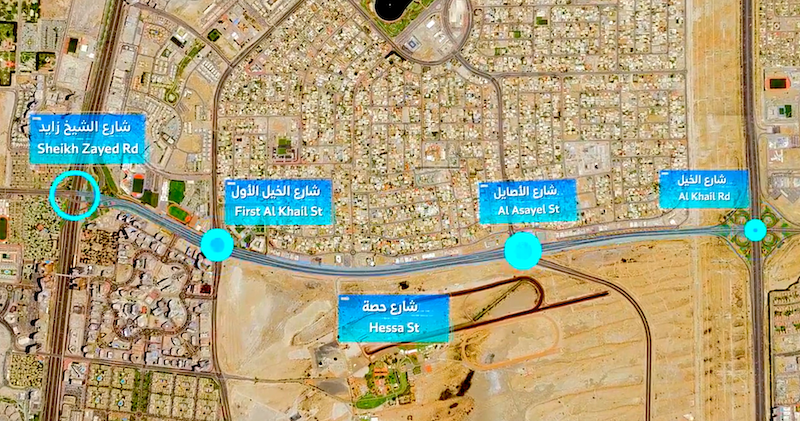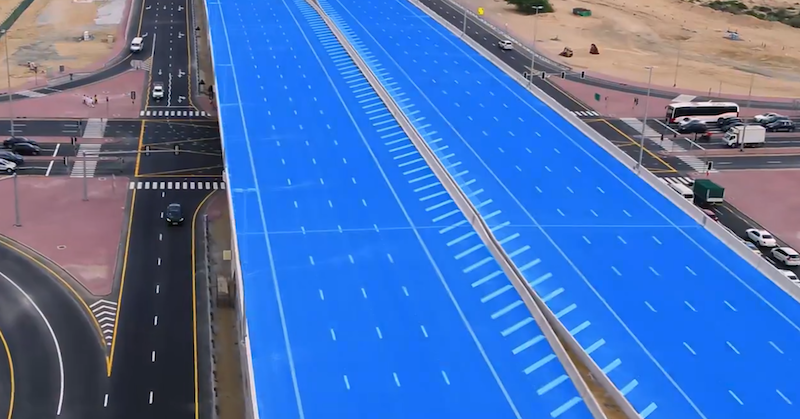Hessa Street to get huge traffic reducing remodel and cycle track
Bye, red lines on Google Maps…
Anyone who’s ever had to use Hessa Street in rush hour will be celebrating hard this week, with the news that the thoroughfare will undergo a huge Dhs689 million improvement.
It’s in response to the directive issued by His Highness Sheikh Mohammed bin Rashid Al Maktoum, Vice-President, Prime Minister of the UAE, Ruler of Dubai, to keep the city’s road infrastructure in pace with the emirate’s other development. Work will be carried out by the Roads and Transport Authority (RTA).
What changes can we expect to Hessa Street traffic?
The project will focus on the 4.5 km stretch of the Hessa Street corridor between the Sheikh Zayed Road (E11) and Al Khail Road (E44).
Within this space, the RTA will be revamping the four main intersections – Sheikh Zayed Road, First Al Khail Street, Al Asayel Street, and Al Khail Road.
This will effectively double the number of lanes on Hessa Street from two to four (in each direction), and therefore boost Hessa Street’s traffic capacity by a full 100 per cent, which will enable the volume of traffic to accommodate 8,000 vehicles per hour. And, we don’t have the stats on this but, a significant reduction in teary-eyed incoherent screaming into your steering wheel.

RE: Cycling
And there’s great news for the city’s evergrowing number of biking enthusiasts, with the confirmation that part of the project involves the construction of a brand new 13.5-kilometre cycling track.
The track will measure 4.5 metres in width, with 2.5 metres of that reserved for bicycles and e-scooters, and two metres solely for pedestrians. It will connect Al Sufouh to Dubai Hills, and provide easy safe access to Dubai Internet City Metro Station as well as surrounding commercial spaces.
When will the Hessa Street improvements be finished?
Detailed timelines are yet to be released but His Excellency Mattar Al Tayer, DirectorGeneral, Chairman of the Board of Executive Directors of the RTA did say: “The population of areas served by the project is expected to reach more than 640,000 individuals by 2030.”
Re: Routing
Giving more details on the scheme, H.E. Al Tayer explained that “The project serves several residential and development communities, such as Al Sufouh 2, Al Barsha residential area, and Jumeirah Village Circle.”
“The project includes the improvement of four main intersections. The first is the intersection of Hessa Street with Sheikh Zayed Road which will have a 2-lane directional ramp passing over the route of the Dubai Metro Red Line to serve traffic heading rightward from Sheikh Zayed Road to Hessa Street Eastwards to the Emirates Road. The second entails upgrading the intersection of Hessa Street with First Al Khail Street by increasing the number of lanes on the existing bridge of Hessa Street from three to four lanes in each direction along with traffic improvements to the surface signalised junction.

“The third covers improving the intersection of Hessa Street and Al Asayel Street by increasing the number of lanes from two to four in each direction along Hessa Street in addition to traffic improvements to the surface signalised junction. The fourth is the intersection of Hessa Street with Al Khail Road and includes constructing a two-lane directional ramp to serve the traffic bound Northwards to Al Khail Road in the direction of Sharjah,” explained Al Tayer.
Road to the future
This latest phase of redevelopment follows other recent RTA ramping and revamping projects such as the widening of Sheikh Mohammed bin Zayed Road and Al Khail Road, the construction of the Hessa Street – Al Khail Street flyover, and the Al Barsha to Sheikh Mohammed bin Zayed Road link. This bridge allows smooth traffic to travel to and from Al Barsha via Sheikh Mohammed bin Zayed Road,
There’s also the new ramp over the Al Houdh Intersection which traffic on Al Yalayis Street from Jebel Ali to Sheikh Mohammed bin Zayed Road. The five lane (three in the direction Abu Dhabi to Dubai, and two in the direction of Abu Dhabi.
Images: RTA
